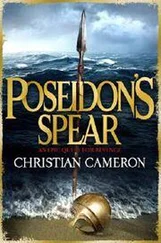Each new submariner also spent half a day shadowing him. Mentally exhausting to be sure, but it had borne fruit in the form of a crew of cohesive submariners and junior officers who were ingrained with the concept of servant leadership.
Today was Ramirez’s day. She stood off his left shoulder, Rite in the Rain notebook and pen in hand, eager to learn.
“Tell me about our enemy, Seaman Ramirez,” Condiff said.
“Our enemy, sir? Here, at this moment?”
“Yes,” Condiff said. “Here on this sub.”
“… Russia, sir?”
“Not at the moment,” Condiff said. He turned to Lowdermilk. “Lieutenant?”
“The sea, Skipper,” Lowdermilk said. “The sea is our enemy.”
“You are correct, Mr. Lowdermilk,” Condiff said. “You may continue driving my boat.”
Lowdermilk grinned. “Aye, aye, sir.”
Condiff took a swig from the water bottle and winked at Ramirez. “I’m not kidding, you know. Even now, Mother Ocean would love to crush our hull with her bare hands. And if she’s unable to do that, she would sink and flood and freeze us without a second thought. Don’t believe me? Punch a tiny hole in the sub and then try to make friends with her. No, ma’am, the sea is an invasive species.” He took another drink and then raised the bottle as if in a toast. “And I love it more than just about any other place on the planet.”
He gestured at the nearest sonar technician. “So Petty Officer Markette, there, is keeping an eye on a surface ship making its way through the ice … Right, Petty Officer Markette?”
“Aye, Captain,” the STS said. “Bearing two-five-five. Heavy, slow screws. Turn count suggests it’s the Healy . Getting a lot of interference from the ice floe, but we’re estimating her at eight miles.”
The U.S. Coast Guard icebreaker Healy had been in the area before they dove. They’d picked up her groaning screws off and on throughout the week as she maneuvered through the ice, along with the periodic groans of a smaller boat they assumed to be an Arctic research vessel.
“Thank you kindly, Petty Officer Markette.” Condiff glanced at Ramirez again. “Ice … just frozen water … so still the enemy …”
Markette sat up straighter in his chair.
“Con. Sonar. Contact,” he said, all business. “Sound transient, far, bearing two-four-zero … Explosion. I think it was a torpedo.”
“I have the con,” Condiff said, moving forward.
“Captain has the con.” Lowdermilk stepped out of the way, deftly nudging Seaman Ramirez with him.
“Station a tracking party,” Condiff said before turning toward sonar.
Lieutenant Lowdermilk relayed the order on the 1 MC, or main communications circuit, alerting the entire ship that a contact needed tracking, but the captain was not quite ready for battle stations. Designated crew, along with the XO, were needed in control.
“Report,” Condiff said.
“Nothing, sir,” Petty Officer Markette said. “The sound of the launch blended with ice noise at first. The fish launched and then detonated … six seconds later.”
“The Healy ?” Condiff said, feeling bile rise in his gut.
“Heavy screws are still present, sir,” Markette said. “Turn count is accelerating. She’s speeding up.”
“Assessment?”
Markette listened to a playback of the noise. “There it is,” he said. “Hiss, crack, boom. I think the transient was a sub firing a torpedo through the ice.”
“No other contacts?”
“No other contacts,” Markette said.
Lowdermilk said, “Shall we find open water and send up an X-SUB?”
The X-SUB was a communication buoy developed by ALSEAMAR, that, when deployed by tether, allowed two-way communication between the submarine and ships or land while staying at depth.
“Not yet,” Condiff said. “I’m not ready to show our hand on the surface quite yet—even with a little buoy. No telling what kind of air assets are up there.” He addressed the petty officers in the pilot and copilot seats, giving them the coordinates and speed he wanted.
“… Take us toward the sound of gunfire …”
32
The other members of ELISE filtered into the secret space by ones and twos, bringing small boxes of supplies for their desks—a favorite type of pencil that couldn’t be nabbed at the supply closet, a coffee mug that had served them through many overseas assignments, or maybe a framed photo or two to help anchor them to normal life … whatever that was. Smartwatches, Fitbits, iPads, or outside electronics of any kind were not allowed.
Hendricks, Wallace, and Li had worked through a pool of thirty prospective personnel files and sent nine names to DNI Foley for approval. Once Foley signed off, Hendricks and Wallace had met with each of them personally and invited them to apply to participate in a special project that would require in-depth background checks, including a polygraph and a financial review that one of the men later described as more intrusive than a lingering prostate exam. Hendricks, Wallace, Li, and even Director Foley worked around the clock to complete the vetting process.
No one on ELISE knew how long the assignment would be, but once they found out it was a mole hunt, they were in it for the long haul.
Monica Hendricks sat at the head of a long oak conference table, flanked by David Wallace of the FBI and retired rear admiral Peter Li, her longtime friend and unofficial deputy on project ELISE.
With the last two team members less than five minutes out, Hendricks asked the others to stow their belongings quickly and join her at the conference table. She’d already laid out twelve yellow legal pads and twelve black Skilcraft government pens.
It was often said that it took a spy to catch a spy. Monica preferred to think that it took a spy to catch a rat. Turncoat, sellout, traitor, quisling—many pejoratives fit the bill, but rat was a much better descriptor than mole .
Moles lived underground, out of sight. They were hard to find, but they were blind and witless, digging away toward the smell of food or a mate. Beady-eyed and conniving, rats, on the other hand, slinked through the darkness, eating grain stores, shitting on what they didn’t eat, and spreading plagues.
Rats who sold out to Israel or Taiwan or France, while they couldn’t be forgiven, might at least be understood. Rats who gave up their knowledge to Communist countries were beyond redemption.
Of the twelve people assigned to ELISE, there were seven women and five men. Two were black, three were of Chinese heritage, and two were Hispanic. The rest were white. There was one Southern Baptist, one Lutheran, and one Jew. Agnostics, Mormons, and Catholics tied at three apiece. Everyone in the room spoke at least two languages. More than half, including all the Mormons, spoke fluent Mandarin. Most had graduate degrees, one from Harvard Law School, two were former cops, and two had taught high school. Nine were parents. Three had grandchildren and would gladly show you dozens of photos, though they did not post them on any sort of social media.
An extremely diverse group, but for all their differences, every single member of ELISE hated Communism with the intensity of a thousand suns. Socialism was no better, just Communism by another name. All of them had been around the world and witnessed firsthand the damage Communist regimes rained down on the people. Voicing the notion aloud made one sound like a crazed zealot, but experience had taught everyone in the room that Communism was a fairy tale on paper, the cold reality of which brought riches to the rulers and sorrow, starvation, and death to the ruled. The record of the United States was far from perfect, but those who worked for Monica Hendricks made no apologies for the fervent belief that theirs was not a fight against merely an alternate dogma to democracy, but against evil.
Читать дальше











![Александр Ирвин - Tom Clancy’s The Division 2. Фальшивый рассвет [litres]](/books/417744/aleksandr-irvin-tom-clancy-s-the-division-2-falsh-thumb.webp)
